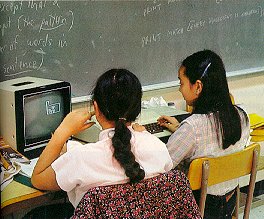|
| with no training in physics, but also people who have taken courses in physics. What we found reflects the problem with designing cyclotrons: it's easy to find people who know the equations, but it's harder to find people who have incorporated that knowledge into their intuition of the world. "For me," Papert adds, "it's clear with students, even at MIT where they're pre-selected for being 'good at' science and math. The fact that they've done a year or two of undergraduate physics doesn't mean they've taken it into their intuition. They know the equations, but when you put them into situations where they've got to act rather than use equations, it's not just that they fall back on Newton, but they fall back on Aristotle." The computer language called Logo that Papert developed and used to create this game was marketed this summer by Texas Instruments for use on its home computers. Papert is now advising Logo Computer Systems, a new company which is developing versions of the language for other home computers and for use in schools. Similarly powerful simulations, using a computer language called Smalltalk, have been developed at the Xerox Palo Alto Research Center, where children have been animating Saturday morning cartoons instead of watching them, designing music and playing with electronic paint brushes. Alan Kay, who directed this research, predicts that home computers that allow kids to do this sort of thing will be on the market, at no higher cost than the current ones, within this decade. And they will be no larger than a school notebook. |
If the new age is anywhere, it may be in the spare, modern office of Steven Jobs, who with his partner Stephen Wozniak invented the Apple computer. On the wall is a sort of computer sampler, the word "THINK" generated in colors of the electronic spectrum. There's an Apple computer beside his desk. The office is in striking contrast to the slicker aura that surrounds it, with a steady coming and going of Silicon Valley executives and sales reps in brass-buttoned blazers, carrying brass-bound briefcases, their faces chiseled out of the sun. Steve Jobs kicks his leather sandals off. He" wears faded jeans and a western corduroy shirt with sleeves rolled up.
Steve and his partner "Woz" may be remembered as the two college dropouts who brought the computer down to earth. "Most people's view of it is still 1984ish," he says, "and yet the way it's really happening is closer to whole-wheat bread! Instead of leading to centralized intelligence, centralized decision-making and personal unenrichment, it's started happening on a personal scale." If the computer is becoming decentralized, cheap and more accessible to the individual, Steve and Woz had a lot to do with all that.
Making the computer adapt to people
Five years ago they decided to make their own computer because they couldn't afford to buy one. "I was working at Atari at the time and Woz worked at Hewlett-Packard designing calculators," Steve recalls, "and we both liberated some parts and built our first computer in the garage of my house. Actually, we started working in a bedroom, but my parents kicked us out to the garage."
The Apple was not the first personal computer, but it was the first popular one because it hooked up to a TV set, something Steve learned from Atari, an idea implicit in Nolan Bushnell's original inspiration. Steve sees the concept of games taking on new meaning as the computer evolves to meet us on our terms. "The challenge," he says, "is to spend more of the intelligence in the box to make the computer adapt to the way people do things rather than what we do now, which is to force people to adapt to the way computers do things." The sort of change Steve Jobs has in mind can already be seen at places like MIT, where an office-of-the-future project includes a computer you can communicate with by touching its screen, or talking to


